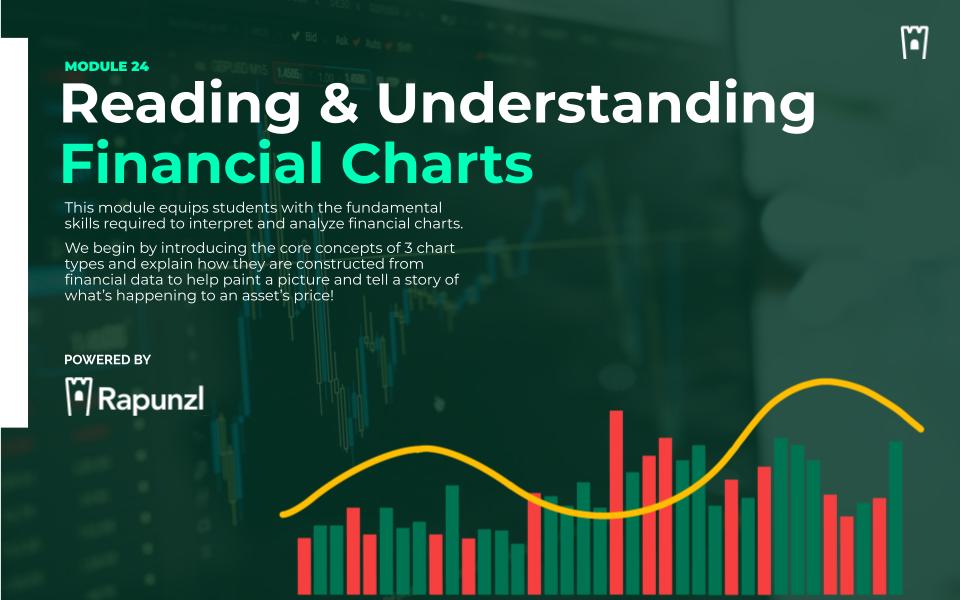
Module 24
Reading Financial Charts
This module equips students with the fundamental skills required to interpret and analyze financial charts. We begin by introducing the core concepts of 3 chart types - line, candlestick, and OHLC - and explain how they are constructed from financial data.
We then delve into the interpretation of these charts, teaching students to discern trends, patterns, and key indicators that are vital in financial decision-making.
Module At A Glance
Grade Levels:
7th - 12th
Est. Length:
1-2 Hours (15 slides)
Activities:
2 Activites
Articles:
4 Articles
Languages:
English & Spanish
Curriculum Fit:
Math, Business, Economics, CTE, Social Studies
Standards Alignment:
CEE National Standards, Jump$tart National Standards & Relevant State Standards

Guiding Questions
- What are financial charts, and why are they essential in investment decision-making?
- How do different types of charts (line, candlestick, OHLC) present financial data, and what unique insights do they offer?
- What is the significance of the data used in financial charts, and how does the choice of time interval affect the information displayed?
- How do popular chart overlays like moving averages and Bollinger Bands enhance the interpretation of financial charts?
- In what ways can understanding and analyzing charts influence investment strategies and risk management?
Enduring Understandings
- Charts are critical in visualizing, interpreting and analyzing complex financial data.
- Different chart types (line, candlestick, OHLC) serve varied purposes and offer unique insights.
- The source of data and timeframes impacts the information a chart conveys, influencing investment decisions.
- Overlays like moving averages and Bollinger Bands provide additional layers of information, helping to identify trends, volatility, and potential trading signals.
- Reading and interpreting charts is integral to developing effective investment & risk strategies.
Module Vocab & Key Topics
Chart
A visual representation of financial data over a specific time period, used to analyze trends and patterns in markets.
Axes
In financial charts, the axes refer to the two perpendicular lines that frame the chart, with the horizontal axis typically representing time intervals, and the vertical axis representing price levels or other numerical values.
Scale
The scale on a financial chart refers to the graduated range of values used to measure the data being represented, such as price or volume; it can be linear, showing equal value intervals, or logarithmic, where each interval reflects a percentage change.
Line Chart
A type of chart that displays information as a series of data points connected by straight line segments, typically used to show trends over time.
Candlestick Chart
A chart that represents price movements within a certain time frame, showing the opening, closing, high, and low prices through a combination of a rectangular body and lines.
OHLC Chart
Stands for Open, High, Low, Close chart, a type of financial chart used to depict price movement over time, displaying the opening, high, low, and closing prices for each time period.
Volume
The amount of an asset or security that changes hands over a set period, an important indicator of the strength or weakness of a market move.
Trend
The general direction in which a market or asset's price is moving, an essential concept in technical analysis to identify potential opportunities.
Moving Average (MA)
A widely used indicator in technical analysis that helps smooth out price action by filtering out the “noise” from random price fluctuations that occur while a stock trades.
Bollinger Bands
A technical analysis tool defined by a set of lines plotted two standard deviations (positively and negatively) away from a simple moving average (SMA) of a security's price.
Relative Strength Index (RSI)
A momentum oscillator that measures the speed and change of price movements, typically used to identify overbought or oversold conditions.
Moving Average Convergence Divergence (MACD)
A trend-following momentum indicator that shows the relationship between two moving averages of a security's price.










